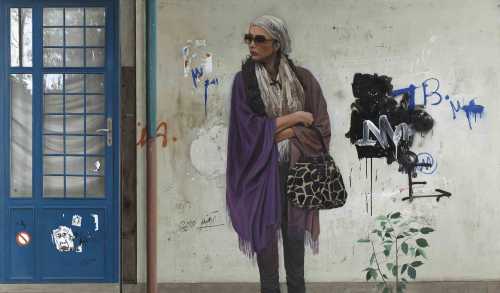About Dariush Gharahzad
Dariush Gharahzad was born in 1976 in Tehran. He started painting when he was 20. His teacher was Mehrdad Jamshidi, who taught him the basics of painting techniques and oil painting. After that, he began becoming a self-taught artist, drawing inspiration from the works of Rembrandt, David Hockney, and Picasso. He also worked in advertising for over 12 years, and he believes being a graphic designer helped him start reviewing his ideas and establishing his painting language.
Dariush Gharahzad has participated in many groups and individual shows at galleries worldwide, such as in the United States, England, UAE, Australis, and of course, Iran, during the years of his activities.
Successful participation in the markets of the world and region had a significant impact on his works and resulted in an in-depth study of social issues. For example, the focused views on women's social space in the cities are clearly visible in his works. Some of his important collections are "Identity," "wall paintings," and "Panorama," which were attended at the Sotheby's, Christie's, bonhams, and Tehran auctions in Iran, UAE, and England (London).
In the Panorama series, he captured people's urban life achieving an attractive expression (pop) from the combination of tradition and modernity and noticing an urban panorama that criticizes people and places with gorgeous faces and a positive attitude. In this movement, the identity of people changed, and the type of clothing, make-up, style, and even their life was changed, and they identified based on their surroundings.
"Iranian contemporary art history" (unveiled at Christie's auction in 2013), "Tehran Art," and "Different Sames" (published in America in 2008) are three valuable books published about Iranian contemporary art history abroad, reviewing a collection of his works in different periods.
Gharahzad's work concentrates first and foremost on the social and urban life of modern-day Tehran and modern urban. In his compositions, color and atmosphere are everything: women walk by wearing headscarves set against colored walls; graffiti, a new form of expression among the urban youth, is reinvented as beautiful. About the walls, he shows us the way he is looking, the abstract modified by the graffiti symbols and lines shaped on the wall. Gharahzad is especially interested in the booming youth culture and how it quietly contravenes the rules of Islamic society: he is trying to show people in some places we don't know where they go or come, what they have in their minds. "My art's message is that the people, especially the young ones, have changed. They need something more interesting than whatever is inside their traditional culture. And these new collections are about women's identification.”
The Most Expensive Artwork
At Auctions
First Attendance
29 April 2009
# Attendance
19
# Artworks
20
Average Realized Price
8,342 USD
Average Min Estimate
5,203 USD
Average Max Estimate
7,282 USD
Sell-through Rate
85%
Average Growth of Artwork Worth
23.146%
Timeline
Arab, Iranian & Turkish Art / Modern & Contemporary Middle Eastern Art | N°22 auction
15 December
CHARSOO- Part 2 exhibition
3 October
Online MIDDLE-EAST: Contemporary Arab, Iranian & Turkish Art auction
17 October
The 20th Tehran- Modern and Contemporary Iranian Art auction
5 July
The 14th Tehran- Contemporary Iranian Art auction
12 August
Humans 2 exhibition
11 December
online studio : group painting exhibition exhibition
14 June
Intangible Silence exhibition
11 October
Another Time exhibition
20 September
The Probably Truth exhibition
23 August
Forty - Fifty - Sixty exhibition
21 June
Drawing Event exhibition
31 May
دهمین دوره حراج تهران auction
11 January
1397#1 exhibition
27 April
Please Step on the Grass exhibition
22 December
"Still Life" Amordad Annual exhibition
4 August
Daily exhibition
10 February
The 6th Tehran- Contemporary Iranian Art auction
23 December
The Winter Experience exhibition
10 June
چهارمین دوره حراج تهران auction
29 May
Islamic and Indian Art auction
9 June
سومین دوره حراج تهران auction
30 May
Ayyam - Dubai - September 2013 auction
16 September
Art for Peace Festival exhibition
1 January
اولین دوره حراج تهران auction
22 May
Modern and Contemporary Arab, Iranian and Turkish Art Part II auction
26 October
Contemporary Art / Arab & Iranian auction
4 October
Modern and Contemporary Arab, Iranian and Turkish Art auction
19 April
For A exhibition
26 November
Drouot Richelieu, Salle 7, Vente Tableaux Modernes auction
19 November
International Modern and Contemporary Art auction
26 October
Contemporary Art / Arab & Iranian auction
20 October
International Modern & Contemporary Art auction
27 October
International Modern & Contemporary Art auction
29 April
